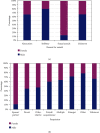Injury Patterns and Demographics in Child and Adolescent Assault Victims Presenting to US Emergency Departments
- PMID: 33163081
- PMCID: PMC7604600
- DOI: 10.1155/2020/8169030
Injury Patterns and Demographics in Child and Adolescent Assault Victims Presenting to US Emergency Departments
Abstract
Objective: To correlate injury patterns with patient demographics in child and adolescent assault victims.
Methods: The National Electronic Injury Surveillance System-All Injury Program data for the years 2005 through 2015 was used. Injuries due to assault were identified and analyzed with SUDAAN 11.0.01™ software to account for the weighted, stratified nature of the data.
Results: There were an estimated 4,407,009 ED visits for assault in patients ≤ 19 years of age. With increasing age, the percentage of females decreased. Sexual assaults were more common in females (87.4%), and robbery/burglary was more common in males (79.8%). When the perpetrator was a spouse/partner, the assault victim was most commonly female (88.8%), and when a stranger, the assault victim was most commonly male (71.5%). With increasing age, the percentage of sexual assaults decreased while the reason for the assault being unknown increased. The assault occurred in the home in 59.6% of those ≤ 4 years of age, decreasing to 18.7% in those 15 to 19 years of age. The anatomic location was the head/neck in 32.8% of those ≤ 4 years of age, increasing to 60.6% in those 15-19 years old. Those ≤ 4 years old had the highest hospital admission rate (8.3%). The main diagnoses were concussion (3.0%), contusion/abrasion (33.3%), fracture (11.5%), laceration (11.5%), internal organ injury (11.5%), puncture (2.8%), and strain/sprain (20.7%). The number of assaults from 2005 to 2015 decreased for all age groups except for those ≤ 4 years old.
Conclusions: These data provide a comprehensive overview of child and adolescent assault victims presenting to the ED in the USA and can be used as background data for further study. The decreasing numbers of assaults over the 11 years of the study are encouraging, and challenges still exist in decreasing the number for those ≤ 4 years old.
Copyright © 2020 Randall T. Loder et al.
Conflict of interest statement
The authors declare that there are no conflicts of interest.
Figures




References
-
- Eveleth P. B., Tanner J. M. Worldwide Variation in Human Growth. 2nd. Cambridge: University Press; 1990.
LinkOut - more resources
Full Text Sources

